How to Create Scrimshaw-Style Engravings with xTool F1
Scrimshaw — the art of engraving intricate designs on ivory, bone, or similar materials — dates back to whalers of the 18th century who etched seafaring scenes onto whale teeth. Today, with modern technology like the xTool F1 laser engraver, artists can create detailed, authentic-looking scrimshaw with remarkable precision. Whether you’re working with mammoth ivory, bone, or synthetic materials, the xTool F1 opens up new possibilities for both traditionalists and contemporary artisans.
In this article, we'll explore how to use the xTool F1 for scrimshaw, the best materials to choose, techniques for achieving an authentic look, and important safety tips to keep in mind.
Why the xTool F1 is Ideal for Scrimshaw
The xTool F1 is a portable, high-speed laser engraver featuring both an infrared (1064nm) and diode (455nm) laser source. This dual-laser system allows you to engrave on a wide range of materials — from plastics and wood to metals and, importantly, organic materials like ivory substitutes, bone, and real mammoth ivory.
Key advantages of using the xTool F1 for scrimshaw include:
-
Precision: The F1 can engrave with pinpoint accuracy, allowing for the fine line work and delicate shading scrimshaw is famous for.
-
Speed: It can engrave small detailed scenes quickly without sacrificing detail.
-
Portability: The compact design lets you take it to art shows, workshops, or exhibitions.
-
Material Flexibility: With its infrared laser, the F1 can mark on hard, smooth surfaces like bone or mammoth ivory with minimal surface damage.
-
Software Control: Using xTool Creative Space or Lightburn, you can design your artwork digitally and translate it into beautifully etched pieces.
Materials for Laser Scrimshaw
If you want to create authentic-looking scrimshaw with the xTool F1, your material selection matters greatly. Good options include:
-
Mammoth Ivory: Fossilized ivory from extinct mammoths, legally available in many states (but not California, New Jersey, or New York).
-
Bone Blanks: Readily available and cost-effective, often from cattle or camel bone.
-
Ivory Alternatives: Such as Micarta ivory, Elforyn, or resin composites that mimic the appearance of real ivory.
-
Tagua Nuts ("Vegetable Ivory"): Eco-friendly option that laser engraves beautifully.
-
Synthetic Materials: Some artists use white acrylics or special laser-friendly polymers.
Tip: Always clean and prepare your surface before engraving. Dirt, oils, or inconsistencies can distort your laser's path.
How to Create Scrimshaw-Style Engravings with xTool F1
Here’s a basic workflow for creating scrimshaw art with your xTool F1:
-
Design Your Artwork:
-
Create a high-contrast black-and-white image in a graphics program like Adobe Illustrator, Inkscape, or even xTool Creative Space.
-
Focus on clean lines — traditional scrimshaw is often line art with cross-hatching for shading.
-
-
Prepare Your Material:
-
Lightly sand and polish your ivory, bone, or blank to ensure a smooth surface.
-
Secure it firmly in place on the engraver bed.
-
-
Set Up the Laser:
-
Use the infrared laser (1064nm) for organic surfaces like bone or ivory.
-
Set low power (around 10-20%) and high speed settings to mimic fine hand engraving without deep burning.
-
Do test burns first! Each material reacts differently.
-
-
Engrave:
-
Import your design and align it precisely.
-
Run the engraving pass.
-
Inspect after the first pass; light "scrimshaw" often benefits from double passes at low power rather than one heavy pass.
-
-
Enhance the Lines (Optional):
-
To achieve the traditional scrimshaw effect, rub dark pigment (India ink, oil paint, or special scrimshaw ink) into the engraved lines, then gently wipe the surface clean.
-
The pigment will remain in the etched grooves, creating contrast.
-
-
Seal the Work:
-
For longevity, lightly seal the piece with a wax or clear acrylic to protect it from oils and moisture.
-
Tips for Authentic-Looking Laser Scrimshaw
-
Use Fine Line Art: Avoid heavy blocky designs — true scrimshaw is all about fine, flowing lines.
-
Mimic Hand Strokes: Randomize your hatch patterns slightly to avoid a "mechanical" look.
-
Control Depth: True scrimshaw doesn’t require deep cuts — shallow, precise lines capture the essence.
-
Experiment with Textures: You can simulate stippling and cross-hatching using variable dot patterns in your artwork.
Safety Considerations
When using the xTool F1 or any laser to engrave organic materials:
-
Ventilation is critical: Engraving bone or ivory produces fine particulate smoke that should not be inhaled.
-
Wear a mask if needed if you’re working in a poorly ventilated area.
-
Monitor the engraving closely: Organic materials can char or ignite if the laser sits too long.
-
Avoid burning old, brittle materials: Fossil ivory can sometimes have cracks; approach delicate materials with caution.
Always follow the xTool F1’s safety guidelines, including using the built-in protective shields and fume extraction if possible.
Conclusion
The xTool F1 laser engraver brings the ancient art of scrimshaw into the 21st century. With its fine detail capability, material versatility, and portable size, it's an excellent tool for artists wanting to recreate the beauty of hand-carved scrimshaw with modern precision. Whether working on mammoth ivory, bone, or ethical alternatives, you can craft stunning pieces that honor this time-honored maritime tradition — while embracing the power of today’s technology.
Happy engraving!
Mammoth Ivory: Prehistoric Treasure and Modern Crafting Material
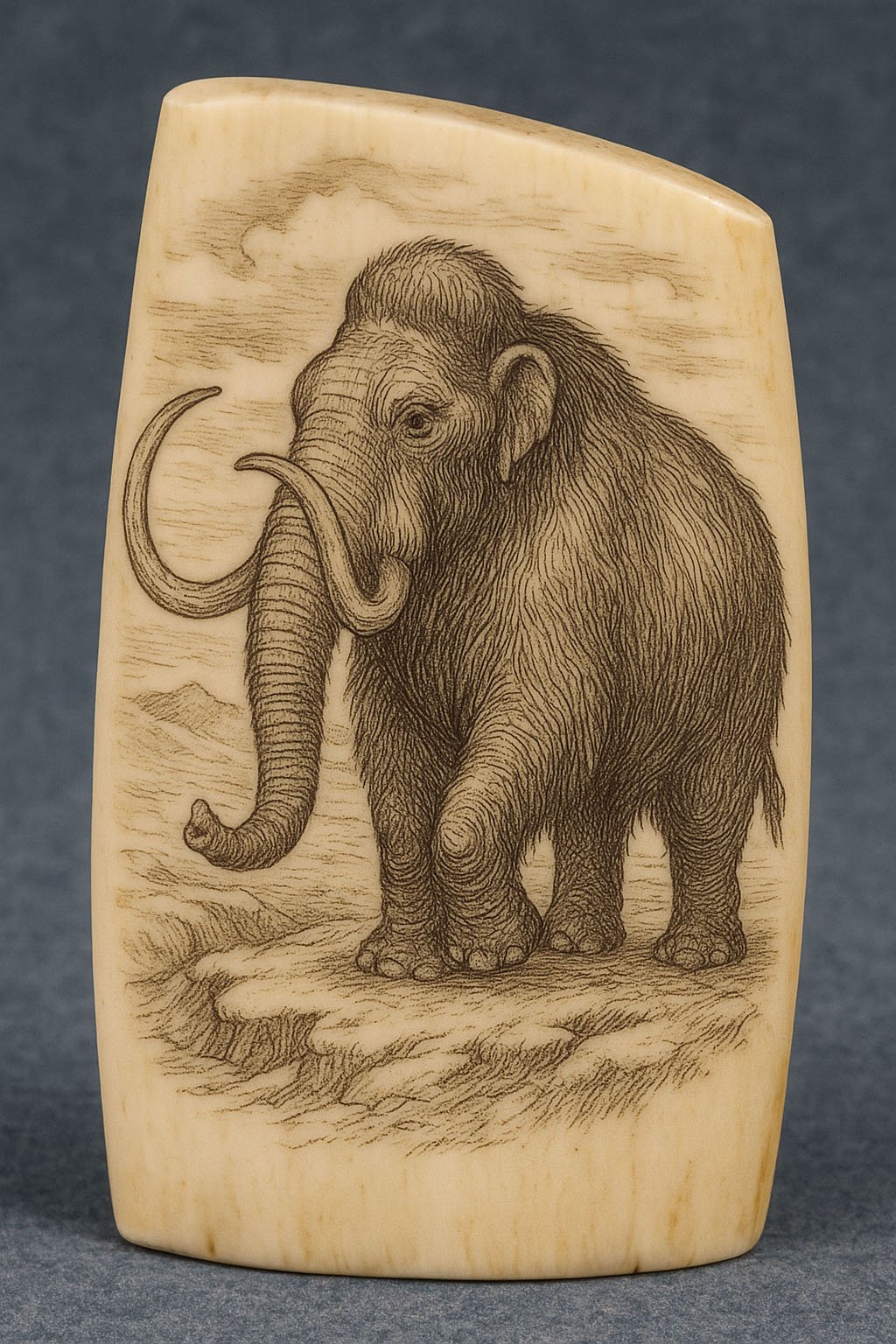
Mammoth ivory is the fossilized tusk material from extinct woolly mammoths (and their relatives like mastodons). This ancient ivory has gained popularity as a legal and ethical alternative to elephant ivory. In this post, we’ll explore what mammoth ivory is and why it’s sought after, where you can legally buy it, the legal considerations you should know (especially in the U.S.), and important safety precautions and challenges when working with mammoth ivory.
What Is Mammoth Ivory and Why Is It Sought After?
Mammoth ivory comes from the tusks of woolly mammoths that lived during the Ice Age, over 10,000 years ago. Many of these tusks have been preserved in permafrost in places like Siberia, Alaska, and Canada until discovered by modern-day hunters and miners. Despite its age, well-preserved mammoth tusk material still has the smooth, dense characteristics of ivory. In fact, mammoth ivory is a rare and prized material traded in luxury collector and artisan markets around the world (Fossil Mammoth Ivory - Arctic Antiques). It has become popular among craftspeople – from knife makers and jewelers to scrimshaw artists – as a substitute for elephant ivory. By using long-extinct mammoths’ tusks, artisans can create ivory artworks without harming any living species, and this fossil ivory trade even helps reduce demand for illegal elephant ivory (Fossil Mammoth Ivory - Arctic Antiques).
Enthusiasts also seek out mammoth ivory for its unique qualities. Each tusk is essentially a piece of prehistoric treasure – often 10,000 years old or more (Mammoth Ivory and Bone | Boone Trading Company). The material can display an astonishing variety of colors and patterns due to minerals seeping in during burial. Collectors value the blues, browns, and cream tones that mammoth ivory offers, which are not found in modern elephant ivory (Fossil Mammoth Ivory - Arctic Antiques). As one dealer explains, mammoth ivory is not only legal but also “rarer, much older and offers an astonishing variety of colours” compared to elephant ivory (Fossil Mammoth Ivory - Arctic Antiques). Holding a piece of mammoth tusk is like holding a fossilized piece of history – it’s both a conversation piece and a high-end crafting material.
Where Can You Buy Mammoth Ivory Legally?
Unlike elephant ivory, mammoth ivory is generally legal to buy and sell in many places because it comes from an extinct creature and isn’t subject to endangered species protections. There is a robust legitimate market for it, and several reputable companies specialize in supplying genuine mammoth ivory. One well-known example is Boone Trading Company in Washington State, which offers genuine mammoth tusks, chunks, and ivory pieces sourced from Alaska, the Yukon, and Siberia (Mammoth Ivory and Bone | Boone Trading Company). Boone Trading Co. has been a popular source for mammoth ivory jewelry, carvings, and raw materials for decades. (They even note that the ivory they sell is at least 10,000 years old (Mammoth Ivory and Bone | Boone Trading Company)!)
In addition to Boone Trading Co., there are other reputable vendors and specialists. For instance, Arctic Antiques GmbH is a leading European trader of premium Siberian mammoth ivory, operating with strict compliance and certification in the fossil ivory trade (Fossil Mammoth Ivory - Arctic Antiques). In Canada, fossil and mineral dealers sometimes carry mammoth tusks or slices for collectors. In the United States, several fossil dealers and knife handle material suppliers offer mammoth ivory (in forms like knife scales, beads, or carving blanks) through their online stores or at trade shows. You might also find mammoth ivory products in some Alaska Native art shops or museums (since Alaska has a rich supply of fossil ivory).
When buying mammoth ivory, always ensure you are purchasing from a reputable source that guarantees the material is genuine fossil ivory. Reputable dealers will often provide information on the tusk’s origin and age. They also stay up to date on laws to avoid shipping to restricted regions (more on that below). If you’re shopping online, look for established companies with clear policies – for example, Boone Trading Company explicitly states which locations they will or won’t ship ivory to, so customers can buy with confidence (Laws). In short, plenty of legal options exist; just do your homework on the seller’s credibility and your local regulations.
Legal Considerations for Buying and Selling Mammoth Ivory
One big appeal of mammoth ivory is that it’s legal under U.S. federal law. Because mammoths are extinct and not protected by endangered species legislation, the extensive federal bans on ivory trade do not apply to mammoth ivory. In 2016, the U.S. enacted a near-total ban on interstate elephant ivory commerce – but that rule explicitly covers only elephant ivory and not fossil ivory like mammoth tusks (Federal Ivory Ban Rule Goes Into Effect July 6, 2016 – Knife Rights). This means that, from the perspective of federal law, trading mammoth ivory across state lines or internationally is permissible (unlike elephant ivory, which is heavily restricted).
However, buyers and sellers must be aware of state laws, which can be more strict. In response to elephant poaching and the difficulty of distinguishing ivories, some states have passed their own bans that include mammoth ivory. California, New York, and New Jersey are notable examples of places that prohibit the sale of mammoth ivory. New Jersey and New York were among the first – New Jersey enacted a broad ivory ban in 2014, and New York followed in 2015, both banning sales of any ivory (modern or fossil) within their states (Warning! Mammoth & Mastodon ivory illegal to sell in CA on 7/1). California’s ivory law took effect on July 1, 2016, and it explicitly defines “ivory” to include mammoth and mastodon tusks, making it illegal to sell any fossil ivory in California (Warning! Mammoth & Mastodon ivory illegal to sell in CA on 7/1). In practical terms, if you live in those states, you generally cannot buy or sell mammoth ivory (even though it’s from an extinct animal) – doing so risks confiscation of the item and hefty penalties under state law (Warning! Mammoth & Mastodon ivory illegal to sell in CA on 7/1).
Washington State, by contrast, allows mammoth ivory trade. In Washington (where mammoth remains are occasionally found), the state’s wildlife trafficking ban passed by ballot initiative in 2015 only covers living species like elephants, and did not include fossil mammoths (Laws) (States and Countries Banning the Sale of Fossil Ivory and proposed Legislation). Thus, mammoth ivory remains legal to buy and sell in Washington. In fact, Boone Trading Company is based in Washington and continues to freely sell mammoth ivory there and elsewhere. Their policy highlights the patchwork of laws: they will ship mammoth ivory worldwide (except to India, which has its own ban on importing it) but refuse to ship any ivory to New Jersey or mammoth ivory to New York due to those states’ laws (Laws) (Laws).
Bottom line: Always check your local laws before purchasing mammoth ivory. Federally it may be legal, but if you’re in (or shipping to) a state like CA, NY, NJ (or Hawaii, Illinois, and a few others with bans), you could be breaking the law. If you’re outside the U.S., also verify your country’s regulations – for example, India has banned mammoth ivory imports (Laws). Responsible dealers usually know where they can legally ship, but it’s wise to double-check so your prized mammoth ivory purchase doesn’t run afoul of any rules.
Dangers and Precautions When Working with Mammoth Ivory
Mammoth ivory may be exciting to work with for carving, knife handles, jewelry, or other crafts, but it presents some special challenges and dangers that craftsmen should keep in mind:
-
Fragility and Cracks: Remember, this material is thousands of years old. Even well-preserved mammoth ivory can be more brittle than fresh ivory. Many tusks have natural fissures from age or from drying out after excavation. If you’re cutting or shaping mammoth ivory, work slowly and avoid sudden temperature or humidity changes that could cause the ivory to crack. It’s often wise to stabilize the ivory (some pieces are resin-impregnated by suppliers) or at least let it acclimate to your workshop environment before working. Also, use sharp tools and light cuts – forcing it can lead to chipping or splitting an irreplaceable piece of fossil ivory.
-
Dust Inhalation Hazard: Ivory (and bone) dust is not something you want in your lungs. When you saw, sand, or grind mammoth ivory, it produces fine particulate dust. This dust can irritate your respiratory system, and may even contain minerals or pathogens from the fossil (though most is just organic particulate). Always wear a proper dust mask or respirator when working with ivory to avoid inhaling the dust, and use local exhaust ventilation or work outdoors if possible. Treat mammoth ivory similar to hardwood or bone in terms of dust – it’s an organic material that can cause lung irritation or allergic reactions if breathed in. Take care to keep your workspace clean (vacuum or wet-wipe the dust, don’t just blow it around) to protect yourself and others. Safety goggles are also important, as tiny ivory chips or dust could irritate your eyes.
-
Proper Handling and Care: If you have raw mammoth ivory or finished pieces, store them properly. Keep ivory away from extreme heat or direct sunlight, which can dry it out and cause warping or cracks. It’s best kept in a stable, moderate environment (not too dry, not too humid). When shaping it with power tools, avoid overheating the ivory – excessive heat from sanding or drilling can discolor or crack it. Many artisans use water or coolant when cutting fossil ivory to keep it cool. And because larger mammoth tusk sections can be valuable, plan your cuts carefully to maximize usable material and avoid waste or accidents.
In short, working with mammoth ivory requires caution and respect for the material’s age and composition. With the right safety gear and gentle technique, you can craft beautiful items from mammoth tusks – but ignoring precautions could harm both your project and your health.
Conclusion
Mammoth ivory occupies a fascinating intersection of history, art, and law. It is literally a piece of the Ice Age that has found new life in modern craftsmanship. Sought after for its beauty and legal status, mammoth ivory can be purchased from specialized dealers (like Boone Trading Company in Washington (Mammoth Ivory and Bone | Boone Trading Company)) as long as you follow your local laws. Federally, it’s an accessible alternative to banned elephant ivory, though a few states have shut down trade even in fossils. For those lucky enough to work with this material, remember that it needs to be handled with care – both to preserve the precious ivory and to protect your own well-being (dust masks on!).
Mammoth ivory’s journey from prehistoric permafrost to contemporary art is a testament to human creativity and our desire to preserve the past. By understanding the legal landscape and respecting the material’s quirks, collectors and craftsmen can continue to enjoy this “ancient material” in a responsible way (Laws). Whether you’re a hobbyist carver or just an intrigued reader, we hope this overview of mammoth ivory helps you appreciate why this fossilized treasure has so much mammoth appeal. 🐘✨
Sources: Primary sources include Boone Trading Company (a mammoth ivory supplier) on legal and shipping policies (Laws) (Laws), a fossil ivory trade article by Arctic Antiques on the appeal and ethics of mammoth ivory (Fossil Mammoth Ivory - Arctic Antiques) (Fossil Mammoth Ivory - Arctic Antiques), and state law information (e.g. California’s ivory ban) from public reports (Warning! Mammoth & Mastodon ivory illegal to sell in CA on 7/1).
How to Make a Scrimshaw Pocket Knife: A Step-by-Step Guide
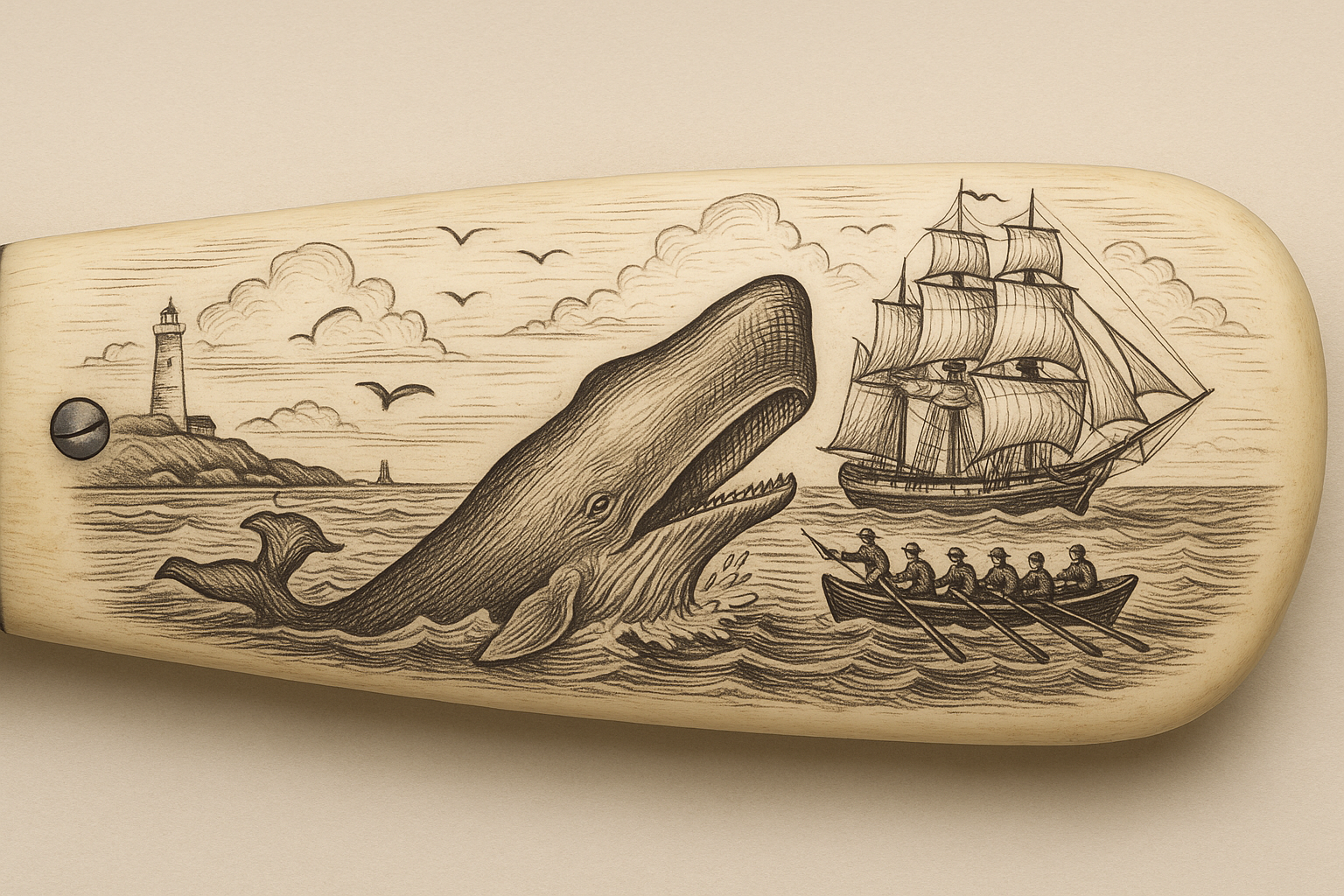
Scrimshaw—the art of engraving intricate designs into bone, ivory, or faux ivory—has long been a treasured tradition among sailors and craftsmen. Combining this timeless art with a practical tool like a pocket knife creates a one-of-a-kind heirloom piece that blends functionality and artistry. In this guide, we'll walk you through how to make a scrimshaw pocket knife, from choosing materials to finishing your design.
Materials You Will Need:
-
Pocket Knife with Bone, Ivory, or Micarta Scales (handles)
-
Sharp Scribe or Etching Needle
-
India Ink or Black Oil Paint
-
Fine Sandpaper (400 to 1200 grit)
-
Soft Cloths
-
Isopropyl Alcohol
-
Magnifying Glass or Optivisor (optional, for detailed work)
-
Pencil and Tracing Paper
-
Fixative Spray or Clear Sealant (optional)
Step 1: Select Your Knife
Choose a quality pocket knife with plain, light-colored handle scales made from:
-
Bone
-
Ivory (faux ivory is commonly used today)
-
Micarta or similar ivory-like material
The lighter the handle, the better your design will show. Make sure the handle is smooth and free of deep pores or cracks.
Step 2: Prepare the Surface
Use fine sandpaper (starting around 400 grit and moving up to 1200 grit) to gently polish the surface of the handle. This ensures a clean, smooth surface for better engraving and ink adhesion.
Wipe the handle down with a soft cloth and a little isopropyl alcohol to remove any dust or oils.
Step 3: Plan Your Design
Using a pencil and tracing paper:
-
Sketch your design first.
-
Stick to bold, simple outlines if you're a beginner.
-
Nautical themes like ships, whales, anchors, compasses, and sailors are traditional and look fantastic.
Once you're satisfied, transfer the basic outline lightly onto the handle with a pencil. You can also freehand if you're confident.
Step 4: Etch the Design
Using a sharp scribe or fine etching tool:
-
Lightly scratch along your pencil lines.
-
Keep your pressure consistent.
-
For shading, use a series of tiny dots ("stippling") instead of deep lines.
Take your time! Scrimshaw is slow, detailed work. A magnifying glass can help you see fine details better.
Step 5: Ink the Design
After the entire design is etched:
-
Rub India ink or black oil paint over the etched area using a cloth or your finger.
-
Work the ink into all the fine scratches.
-
Let it sit for a few minutes so it settles into the grooves.
-
Wipe off the excess carefully with a clean cloth, leaving ink only in the etched lines.
You may need to repeat this process two or three times to achieve the depth and darkness you want.
Step 6: Finish and Protect
Once your ink is dry and your design looks perfect:
-
Lightly buff the handle with a very soft cloth.
-
(Optional) Spray a very light coat of clear acrylic fixative or sealant over the handle to protect the scrimshaw from fading or wearing off.
Allow everything to cure fully before handling the knife too much.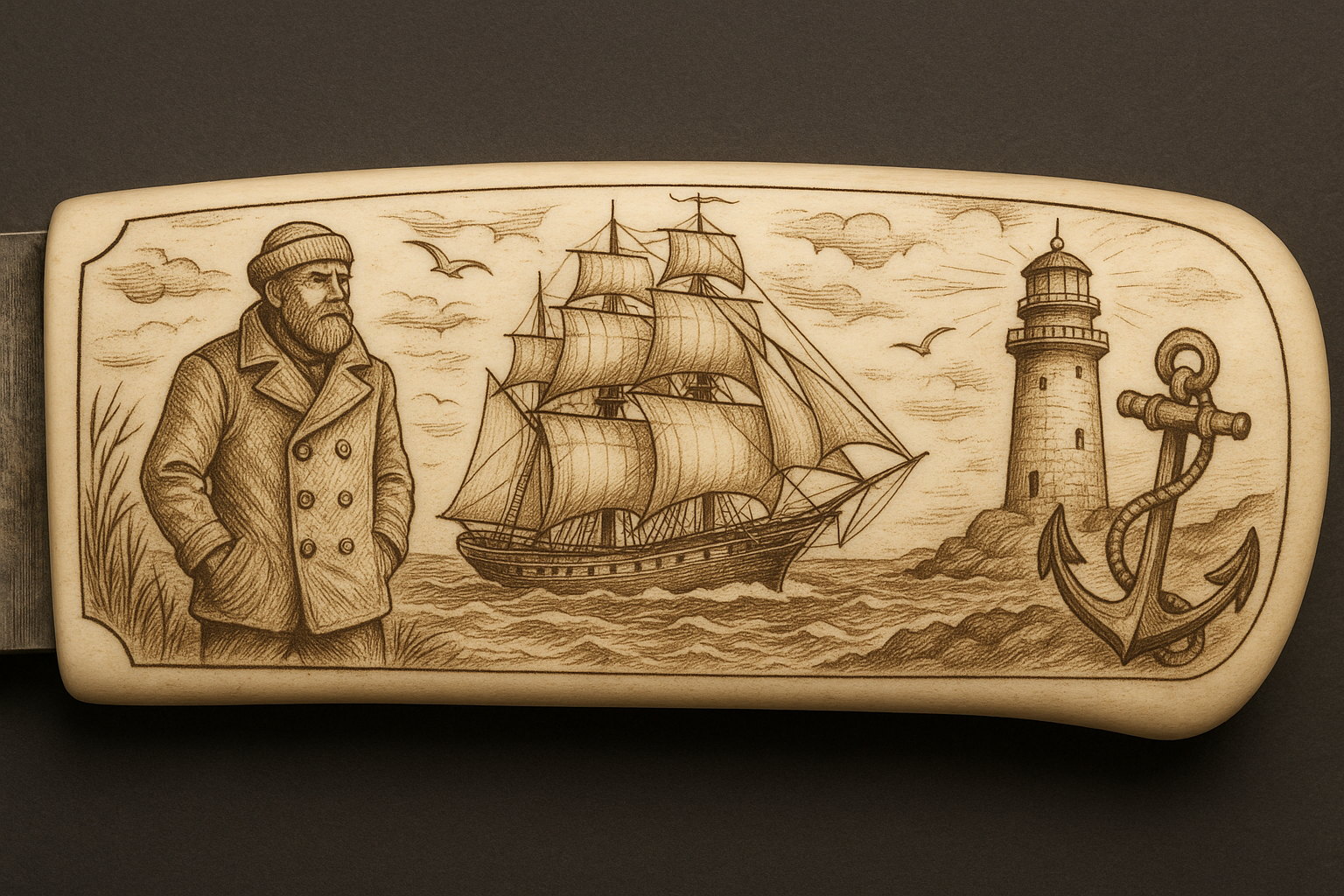
Tips for Beginners
-
Practice on scrap bone or Micarta before working on your knife.
-
Start with simple shapes before tackling intricate scenes.
-
Keep your tools sharp and clean for the best results.
-
Take frequent breaks—scrimshaw demands a steady hand and sharp eyes.
Conclusion
Creating a scrimshaw pocket knife is a rewarding project that connects you with a centuries-old maritime tradition. With patience and care, you can turn an ordinary knife into a unique work of art that carries history, craftsmanship, and your personal touch.
Whether for yourself, as a gift, or even to sell, a handmade scrimshaw pocket knife is a piece to be cherished for generations.
Scrimshaw
The Artistic Process: How Scrimshaw Is Made

Creating scrimshaw is a delicate and highly detailed process. It takes patience and a steady hand. Here’s a step-by-step breakdown:
1. Material Preparation
The surface is polished and sanded to create a smooth, workable canvas.
2. Design Transfer
The artist draws a design directly or transfers a sketch using tracing paper.
3. Engraving
Using a fine-point scribe or etching tool, the design is carefully cut into the surface—line by line.
4. Inking
Ink or pigment is rubbed into the engraved lines and wiped clean from the surface, leaving the ink embedded in the etched grooves.
5. Finishing Touches
The piece is polished or sealed to preserve the art and protect the material.
Some artists incorporate color or gold leaf, while others remain faithful to the traditional sepia-toned look of aged scrimshaw.
The Origins of Scrimshaw
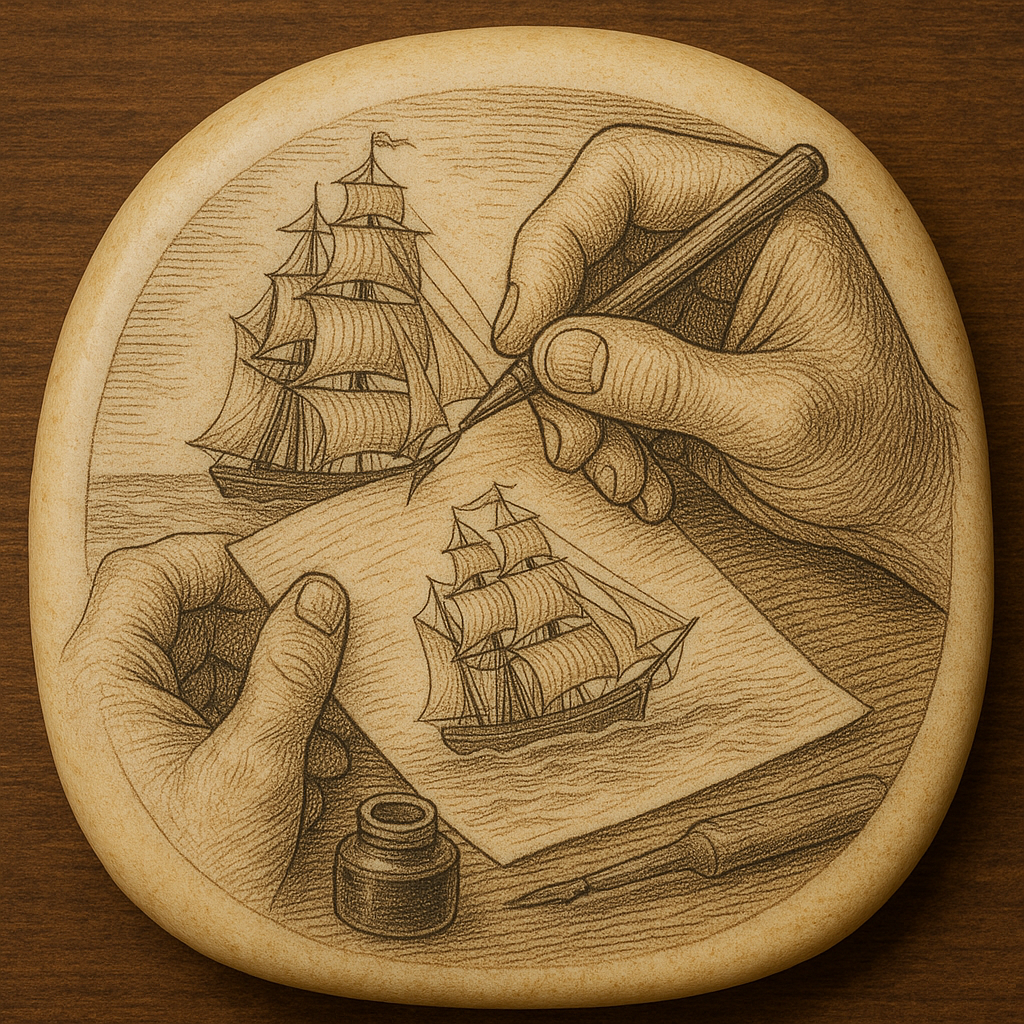 |
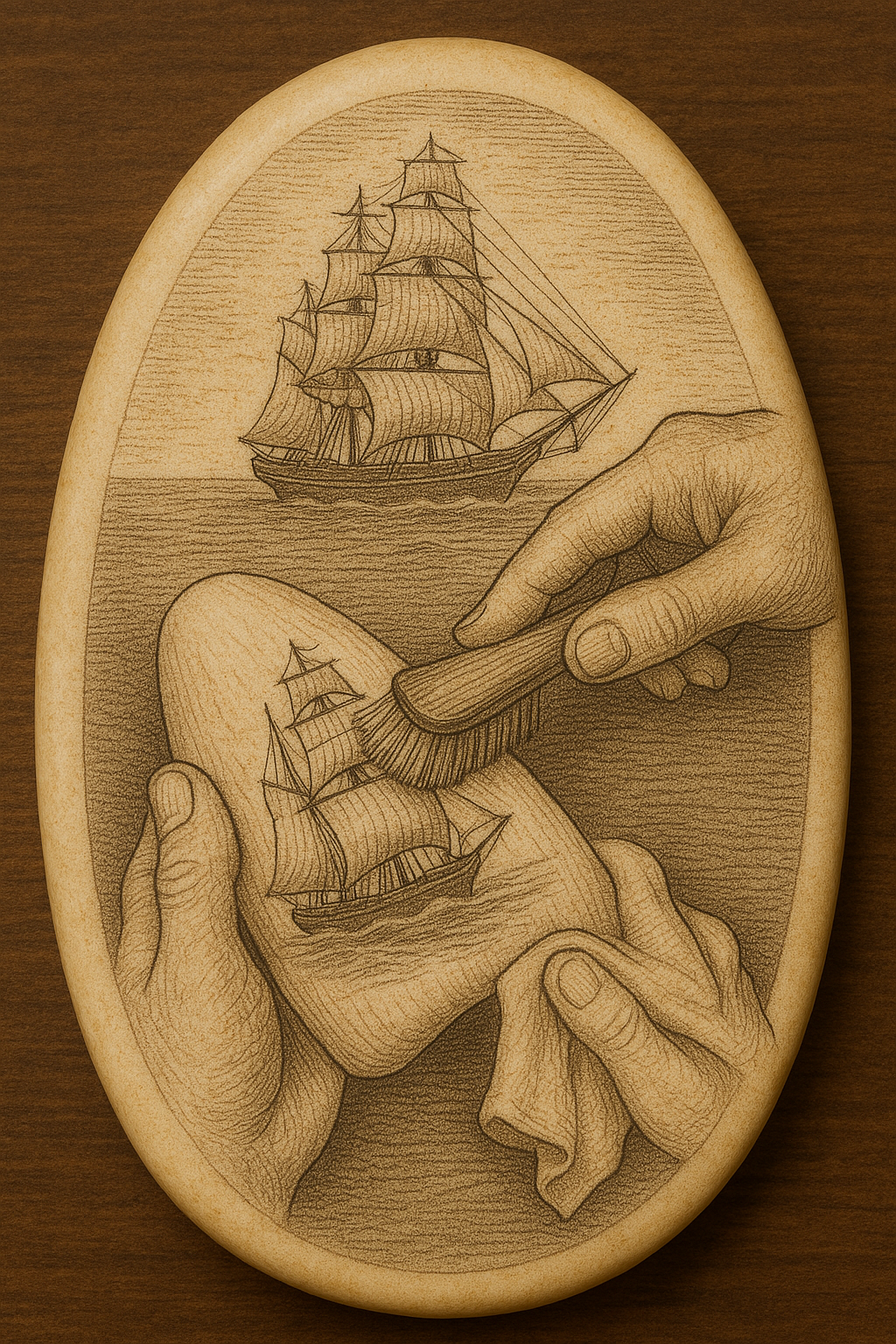 |
The word “scrimshaw” first entered the lexicon in the early 19th century. It’s believed to derive from the Dutch word schrimshander, a slang term for “waste time.” That’s fitting, as the art was originally developed by whalers during long, idle periods at sea. These sailors would use their downtime to etch onto leftover whale parts, creating highly detailed artwork as keepsakes, trade goods, or personal expressions.
⚓ Maritime Connection
Scrimshaw is deeply rooted in maritime culture. Sailors often engraved what they missed most—home, sweethearts, and the ships they called home. It’s not just art; it’s history captured in bone.
What Materials Are Used?
Traditional scrimshaw was etched on:
-
Sperm whale teeth
-
Walrus tusks
-
Baleen
-
Whalebone
These materials were byproducts of the whaling industry, which was legal and widespread in the 1700s–1800s. Today, modern scrimshaw artists use ethical alternatives, including:
-
Antler or bone (elk, deer, buffalo)
-
Tagua nut (a plant-based ivory substitute)
-
Faux ivory (micarta, corian, or acrylics)
-
Eco-resin and other synthetic materials
The goal is to preserve the art form while respecting endangered species protections and ethical sourcing.
